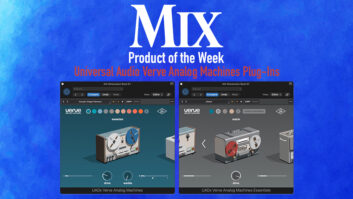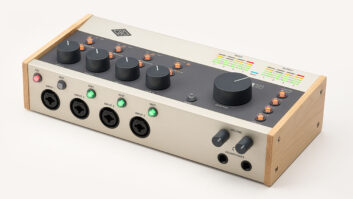
Universal Audio is generally known these days for re-releases of its legacy analog processors such as the LA-2A and 1176, along with some newer combo units such as the LA-610, marrying classic hardware into “greatest hits” hybrid packages. Breaking that mold, the company has now ventured into new territory with the release of two multichannel mic preamps: the 8110 (reviewed here) and the 4110, a 4-channel unit with the same features.
COMMAND AND CONTROL
The three-rack-unit box’s front panel is simply laid out in a polished black finish with the controls positioned vertically, API style. Each preamp has a three-position switch offering variable impedance (500 or 2k ohms) and the ability to switch the input to line input, plus gain control and an output level control. Between the level controls is a three-position Shape rotary knob: The Modern mode (labeled Off) provides lots of clean wide-band gain. Position 1, a Vintage mode, adds transformer loading with greater gain, providing more midrange and level. Position 2, a Saturate mode, maintains the same transformer loading, but adds additional loading at the first amplifier and soft limiting; again, with more gain producing more effect.
Additionally, the front panel carries four blue-lighted switches providing phantom power, a 15dB pad (actually, 12.7 dB when bench-measured, depending on source impedance and the selected input impedance), low-end roll-off (6 dB per octave at 100 Hz) and polarity switching. Above this is a single tri-color input LED and a four-segment output LED. These meters were well calibrated, with the appearance of the orange light within 0.1 dB across all channels. The back of the unit offers eight line inputs, eight mic inputs and eight line outputs, all on balanced XLRs. The power supply is internal.
Go to the Focus on Universal Audio page to see video and learn more about UA products.
IN THE TRENCHES
Using the LEDs as a guide, optimal level setting was a breeze. I set the output all the way to the left, brought up the mic gain control until the tri-color LED clipped and then backed it off. At that point, I could set the output control until I was hitting the recorder just right.
The 8110 boasts a remarkable 10 to 60k Hz (±0.1dB) frequency response and offers up to 74 dB of clean gain. I first heard the preamps on an acoustic guitar tracking session recorded to an Otari analog 2-inch machine. Guitar was recorded first with a pair of AT4051s and then a pair of AT4047s, with the 8110’s Shape switch in Off. This setting provided a balanced and clean sound, albeit one lacking personality — at least compared to the other settings, which I’ll get into shortly. With the Shape switch in Position 2, the preamp exhibited more presence and level and a lot more personality — the guitar jumped out of the track. From this session on, the Shape switch Position 1 became my initial setting. When used to record a guitar amp, the Position 1 effect became much more apparent, filling out the mid and low end substantially. The effect is not subtle, which is great.
Another great way to shape the tone is by switching the impedance setting between 500 and 2k ohms. This feature came in handy when recording a bass through a DI. The bass produced more level when the impedance was switched to 2k, which better matched the DI’s output, producing more level and a richer tone with more low end.
Next, I used the 8110 to record the kick in/out, snare top/bottom, overhead and a drum kit’s stereo pairs, with the rest of the mics coming through SSL 4000 Series preamps, all directly to an Otari RADAR. The ability to change the 8110’s tone by hitting the input a bit harder was fantastic. I could change the tone on selected mics by goosing the gain a bit and backing down the output level. This technique, used with tweaking the Shape switch for a cleaner or more pushed tone, provided a wealth of possibilities. As part of this session, I used the 8110 with an AEA R92 ribbon mic in the room. The pre had more than enough gain for the ribbon and never sounded noisy. The 2k setting was perfect for this application, offering plenty of impedance headroom.
I used six of the preamps to record various passes of a percussionist using a 5.1 ITU surround mic array into Pro Tools. I used AT4051s for the LCR, AKG 451Es on the rears and a Neumann U87 for the LFE. By putting the Shape switch into Position 2, I was able to drive the ambient (off-axis to the performer) mics hard and saturate them without clipping them in Pro Tools. This trick had the effect of filling the room — definitely making the track.
THE 411 ON THE 8110
The tonal variations you can get with the 8110 are truly marvelous. Even when I took the unit to extremes, it was still hard to make it sound bad; there was plenty of clean gain. The fit and finish is excellent and the knobs are solid and stick nicely where you set them. It feels like quality. Its $5,250 MSRP (around $4,500 street) price may sound high, but when you consider that you’re getting eight quality preamps, infinitely variable tone shaping and impedance matching — all for well under $700 each — it more than justifies the price.
Even so, if the 8110 is too dear, you can go with the 4110, which offers four preamps with the same features, plus a DI input for $3,195. What’s not to like?
Universal Audio, 866/UAD-1176, www.uaudio.com.
Kevin Becka is Mix’s technical editor.







